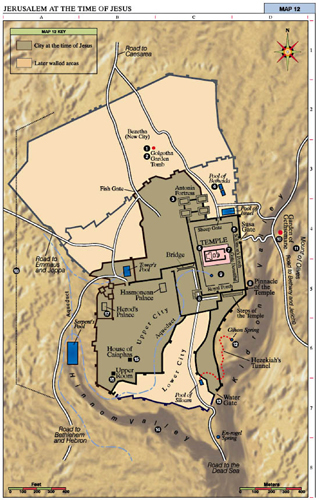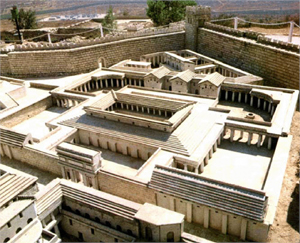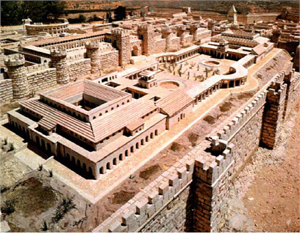
Christmas
Easter
Pentcoest
All Saints
Christ The King
Confirmation
Palm/Passion
Reformation
Stewardship
Books of the Bible
Lenten Series
Christmas Dramas
Videos
Series A - Matthew
Series B - Mark
Series C - Luke
Series D - Other
To contact
Edward F. Markquart
info@sfs.com

Series B John 18:33-37 The following Bible study is from a larger course entitled, THE LIFE OF CHRIST: A Study in the Four Gospels. This 54 week course for the laity will be available for congregations in 2006. Basic text for the course: SYNOPSIS OF THE FOUR GOSPELS, Kurt Aland, English Edition, P. 307. #334, #336. Jesus Delivered To Pilate, The Trial Before Pilate Matthew 27:1-14, Mark 15:1-5, Luke 23:1-5, John 18:28-38 -Then they led Jesus from the house of Caiaphas. (John’s gospel) We remember from earlier lessons that Herod the Great (Herod the Great Builder) had erected several large, grandiose Roman buildings in Jerusalem. We remember that the Romans were fine craftsmen and artisans. These Roman buildings in Jerusalem would have been as opulent as similar buildings in Ephesus and other centers of Roman culture. Unlike Ephesus, the Roman armies leveled Jerusalem in 70 CE. But during Jesus’ time on earth, there were several grand Roman buildings in Jerusalem. Jesus visited an impressive city. In the diagram below, identify both the house of Caiaphas and Herod’s palace. It is most likely that Herod’s palace was the official residence of Governor Pontius Pilate when he visited Jerusalem for special occasions such as the Passover feast. Herod’s palace is “the preatorium” in the gospels. This is review from last week. http://scriptures.lds.org/biblemaps/12 A person can see models of the Palaces of Caiaphas and Herod in the Holy Land Hotel. http://www.bible-history.com/jerusalem/firstcenturyjerusalem_palace_of_caiaphas.html Palace of Caiaphas This is where informal meetings of a small Sanhedrin were held. Peter denied Jesus in one of these courts. This model at the Holy Land Hotel is a scholar's conception showing how the site may have looked in Jesus' day. -To the headquarters (the praetorium.) The praetorium“denotes the place of residence of the chief official in the subjugated Roman territory. In Palestine, the Roman governor’s permanent residence was at Caesarea (Acts 23:33-35 which places the Roman governor in the praetorium of Herod.) Here we are concerned with the governor’s residence in Jerusalem, occupied during festivals or in times of trouble. … (The gospels) envision a large building with an outside court where the Jewish crowd would assemble. There would have been inside rooms, including bed chambers (e.g. Pilate’s wife) and barracks for soldiers. … The location of the Jerusalem praetorium is uncertain, but there are two likely candidates, both mentioned by Josephus. 1) The fortress of Antonio and 2) The Herodian Palace on the West hill (today near the Jaffa gate) which dominates the whole city. Herod the Great built this as a more grandiose dwelling and moved here from the Antonio in 23 BC. From the evidence in Josephus and Philo, this served as the usual Jerusalem residence for the Roman procurators.” (Brown, JOHN, V. 2, p. 845.) http://www.bible-history.com/jerusalem/firstcenturyjerusalem_herod_s_palace.html Palace of Herod “King Herod built a fantastic fortified palace to provide protection for the Upper City. Just like the Temple, Herod's Palace was constructed on a platform, about 1000 feet (from north-south), and 180 feet (from east-west). The Palace consisted of 2 main buildings, each with its banquet halls, baths, and accommodation for hundreds of guests. It was surrounded with groves of trees, canals, and ponds studded with bronze fountains.” The praetorium of the trial of Jesus was located at Herod's palace which was actually the official residence of the Roman governors when they came to Jerusalem during major Jewish festivals. Unfortunately, nothing remains of its construction. This model at the Holy Land Hotel is a scholar's conception showing how the site may have looked in Jesus' day.” Remember that we are dealing with grandiose Roman architecture and construction. If a person visits Rome or Ephesus today and sees the ruins from the grand Roman culture of the past, a person is overwhelmed by the engineering, architecture and construction of these Romanesque colossal sites. The Roman architecture in Jerusalem was no different. The Jerusalem of Jesus’ day was not a backwater “hick town” but the capitol city of that area of the world. Jerusalem could “boast” of many large Roman buildings erected by the builder of all builders, Herod the Great. On the above model, focus on the platform which was longer than three football fields. Memorize the grandeur of the building in the model above. It seems to be an accurate representation of the building in which Jesus was tried by the Roman governor and then scourged. -It was early in the morning. At daybreak. The Roman officials began their work before dawn. -They themselves did not enter the headquarters (praetorium),so as to avoid ritual defilement and to be able to eat the Passover. “The reference to the coming Passover supper makes it clear that for John, Jesus was tried by Pilate and crucified on the day before Passover.” (Brown, JOHN, V. 2, p. 846). -So Pilate went out to them and said, ‘What accusation do you bring against this man?’ This is the first mention of Pilate in the book of John. Pontius Pilate’s name would have been known to the early Christians since his name is mentioned it the book of Acts (3:13, 4:27. 13:28) and also in the Apostle’s Creed. “He was of lower nobility as contrasted with senatorial rank. He ruled Judea from 26-36 AD. Judea was a lesser imperial province. … Pilate is usually identified as a procurator. … A reasonable amount about Pilate is known from Jewish writing and the picture is not favorable. Philo attributes to Pilate robbery, murder and inhumanity. Josephus writes vividly of his blunders and atrocities (e.g. the slaughter of the Galileans mentioned in Luke 13:1).” (Brown, JOHN, V. 2, p. 847). FROM A SERMON
This is clearly expressed in a poem:
-They answered, ‘If this man were not a criminal, we would not have handed him over to you.’ The Jewish authorities knew that only the Romans had the power to execute Jesus. -Pilate said to them, ‘Take him yourselves and judge him according to your law.’ Pilate knew the Roman law and Jewish law. Pilate didn’t want to get involved in this mess. He didn’t want to get involved with an “in house” squabble among the Jews. - The Jews replied, ‘We are not permitted to put anyone to death.’ (This was to fulfill what Jesus had said when he indicated the kind of death he was to die.) The phrase, “the Jews” is a summarization of all those Jewish leaders who were hostile to Jesus e.g. the elders, scribes, Pharisees, Sadducees and others in positions of governing authority. Jesus knew by what kind of death he was going to die. He had prophesied that he was to “be lifted up” and to be “lifted up” meant to be “lifted up” onto a cross, which was the Roman means of execution. The Roman government retained the power to execute. That is one primary way that the Romans retained political power in their provinces. “A death penalty could not be executed unless Rome issued it (Josephus Jewish Wars 2.8.1 117; Jn 18:31). So the leadership takes Jesus to Pilate. The charges must be formulated in a way that causes Pilate, as procurator and protector of Roman regional concerns, to be worried about his future as governor if he does not stop Jesus. (Kinman 1991).” http://www.biblegateway.com/cgi-bin/webcommentary?language=english&version=niv&book=luke&chapter=23 - They began to accuse him, saying, ‘We found this man perverting our nation, forbidding us to pay taxes to the emperor, and saying that he himself is the Messiah, a king.’ Then Pilate asked him, ‘Are you the king of the Jews?’ He answered, ‘You say so.’ (Only Luke) The Jewish leaders wanted to frame Jesus, so that he would be executed. The charges that needed to be brought against Jesus was that he was a revolutionary, and not loyal to Caesar. We recall that Pilate had faced thirty-two riots in his term in office and he knew first hand the political pandemonium associated with revolutionaries. "He opposes payment of taxes to Caesar." This charge concerning the poll tax is patently false, as 20:25 has already shown. But the charge is clever, because Pilate's major political responsibility is the collection of taxes for Rome. A second element in the charge is also a source of concern. The taxes go to Caesar, raising the issue of Pilate's personal loyalty or disloyalty. Failure to act against one who opposes Caesar would mean one is not a friend of Caesar either. Servants of Rome unfaithful to Caesar are not servants for long!” http://www.biblegateway.com/cgi-bin/webcommentary?language=english&version=niv&book=luke&chapter=23 The gospel for Christ the King Sunday, Series B, begins here: -Then Pilate entered the headquarters again, summoned Jesus, and asked him, ‘Are you the King of the Jews?’ In the Gospel of Jesus, we find Pilate going in and out of his headquarters. Pilate ordered Jesus into his palace. All four gospels have Pilate asking that same question: “Are you king of the Jews?” Perhaps there was a lingering memory within Pilate’s mind of the Maccabean revolt from years before and the Jewish masses hoping for a political liberator. Such was the mood from the Palm Sunday parade a few days earlier when the masses were calling for a new messiah, a new liberator to free them from the oppression and insensitivities of the Roman occupiers of the land. -Jesus answered, ‘Do you ask this on your own, or did others tell you about me?’ Jesus answered Pilate right back. -Pilate replied, ‘I am not a Jew, am I? Your own nation and the chief priests have handed you over to me. What have you done?’ -Jesus answered, ‘My kingdom is not from this world. Circle this phrase. Underline it. Highlight it. Memorize it. God/Christ is to rule our lives but this reign of God over our hearts and habits is not like the earthly reign of kings. The “kingdom” is Jesus’ primary teaching in the first three gospels. There are miracles of the kingdom, parables of the kingdom, teachings of the kingdom. The kingdom is where ever God/Christ rules in our hearts, lives or our communities. FROM A SERMON
-If my kingdom were from this world, my followers would be fighting to keep me from being handed over to the Jews. But as it is, my kingdom is not from here.’ -Pilate asked him, ‘So you are a king?’ Pilate is interested in this line of questioning. Pilate wants to know if Jesus is really a threat to him. -Jesus answered, ‘You say that I am a king. -For this I was born, and for this I came into the world, to testify to the truth. Everyone who belongs to the truth listens to my voice.’ Jesus’ life had a fundamental purpose and destiny: to witness to the truth. Jesus has come into the world to testify that he wants to rule the hearts and habits of human beings, the minds and movements of our daily lives. That is the truth: Jesus wants to rule our hearts and lives. Jesus wants to be THE Lord of our lives. That was and is the destiny of Jesus. We, the follower of Jesus, know his voice and listen to his voice, as sheep know and listen to the voice of their shepherd. The mark of a loyal disciple is listening, listening to the words of Jesus. We recall the contrast between Mary and Martha. Martha was distracted and worried about many things. Meanwhile, Mary sat at the feet of Jesus and listened to him. The disciples of Jesus listen to his voice. -Pilate asked him, ‘What is truth?’ Circle, highlight, memorize. We remember Pilate for many reasons and one reason we remember him is because of this fundamental question: “What is truth?” Standing in front of Pilate was Jesus who was/is the embodiment of truth. Jesus spoke the truth: the truth that there is a personal God; the truth that God is a loving Father; the truth that God knows the numbers of hairs on our heads; the truth that the great commandments of God are to love God and our neighbor as ourselves. Jesus embodied the truth about God and the way that we human beings are to live and love. What is truth? Look at Jesus, listen to his voice, and see who he is and you will discover the Truth about God and your own life. -After he had said this, he went out to the Jews again and told them, ‘I find no case against him. Three times in the Gospel of John we hear that Jesus was declared “not guilty.” (In John 19: 4, 6). Jesus was also declared “not guilty” three times in the Gospel of Luke also. (Luke 23: 4, 14 22). |


